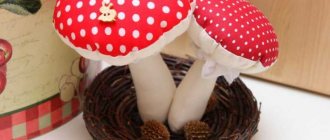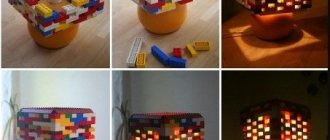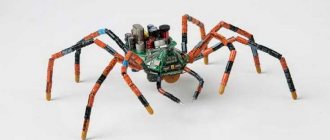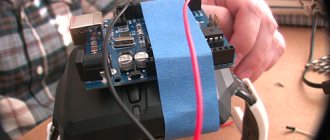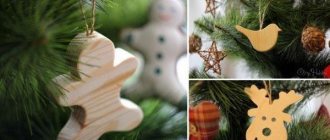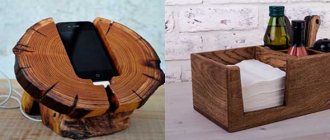by Alexey | Crafts Vintage Decor Workshop Furniture | Wednesday, February 07, 2018
| Follow Make-Self.net on Facebook and be the first to read our articles. |
I am sure that each of you has faced many problems when buying a sofa for your living room. Not satisfied with the size, color of the wood, quality of materials or price. And with the words “Oh, that’s it,” they ran out of the furniture stores in upset feelings. I hasten to inform you that I have found a pill. Why not make a sofa yourself? If you want to make a sofa for relaxing in the garden, I suggest you take a look at our article - 10 Easy Garden Sofa Projects.
No need for sarcastic applause, this is a really good way to save money and do exactly what you wanted. If you have minimal woodworking skills and the right tools, then you can do this task. Take a look at 40 sofa ideas , maybe it will inspire you and save your family budget. Enjoy...
Modern sofa made of several layers of plywood
This tutorial shows in detail the steps to create a modern sofa from plywood, with comfortable side tables and soft leather cushions. Previously, we shared with you ideas - 24 projects that can be made from plywood. This time you will learn how to make your own modern sofa from plywood.
Source : HomeMade Modern
Methods of application
The couch can be regular, anatomical, procedural, and vary in size and purpose.
If you decide that a DIY daybed is the best choice, before you make it, decide where and what it will be used for.
There are several options:
- Country house
. It is enough to make side racks and throw a canopy on top, and you will get an incredibly comfortable place to relax in the open air; - Kitchen
. These are additional seats. And if you make shelves at the bottom, then there is also a place to store kitchen utensils; - Hall, living room
. A place to relax. Especially for people who have back problems. After all, the couch is quite hard, unlike a regular sofa; - Hallway
. Can serve as a place where you will put on shoes and dress your child.
There are more than enough options. Place it in a bathhouse, on a balcony, etc. If you place a soft mattress on top, then the couch can even become a temporary sleeping place.
Furniture board - as a basis for creating a sofa with your own hands
This material is not much inferior to solid wood, but it is much more pliable in processing. The pricing policy depends on several factors simultaneously, the dominant ones being the type of wood and its thickness.
Design Features
It is worth considering the main types of couches:
- the couch-ottoman has a rigid base with a removable solid mattress or flat pillows;
- ottoman couch - an analogue of the previous model, complemented by flat pillows for the back, moved to the wall;
- daybed-banquette - a narrowed and shortened model with a horizontal surface and small side arms-backs;
- a couch-canapé is an analogue of an ottoman with a raised headboard and a shaped incomplete back.
The list goes on, these are not all common or homemade modifications.
Important! For self-production, choose a model that will fit perfectly into the existing interior and complement it.
Other interesting sofa options
Furniture can be made not only from plywood or furniture panels. Take a look at ideas that are worth considering. Perhaps they will inspire you...
Varieties
The headboard of a furniture couch does not have a fixed shape, sometimes it is not provided at all. The frame is made of wood or metal. For upholstery, furniture fabrics or leatherette are used. In showrooms you can find fancy models upholstered in genuine leather; eco-leather is also popular.
Couches are made stationary and folding. Transformers in the form of chairs are equipped with built-in compartments, retractable or roll-out storage systems. In such a sofa-couch you can put away bedding for the day, a good option for a small room.
This is a very beautiful, delicate element of the interior, which was used in their homes by wealthy people, aristocracy, and nobles.
Some modifications are equipped with adjustable base height, have armrests, something like a backrest. The couch has long become a universal piece of furniture, valued for its small format and the possibility of comfortable relaxation. Classic apartment modifications can be found for children, teenagers and adults. Such furniture is installed in living rooms, children's rooms, kitchens, verandas, glazed balconies and loggias.
A couch is a compact sofa designed for one person. Depending on the model. it may look like a sun lounger, chaise longue, or bench.
And other original sofa ideas
Useful short videos from Make-Self.net
Benefits of homemade couches
Before we take the drawings and diagrams for consideration, and also begin to assemble the couch step by step, let’s talk about why making it yourself is a good decision.
The advantages include the following:
- financial expenses only involve the purchase of some materials;
- you get additional space for certain purposes;
- the design is reliable and practical;
- you can do it strictly according to your needs and wishes;
- can fit perfectly into the interior;
- a source of your pride.
If you use the simplest method, based on which you will make a couch with your own hands, you will not need any carpentry skills. Just think through the whole project, make a plan, draw a diagram. Plus, be sure to use good quality materials. Whether it's a frame or a cover. Their manufacture should be made from materials that will not lead to rapid breakdown of the structure.
Upholstery
Upholstery fabric
Proceed with upholstery in the following order:
- cut two pieces of foam rubber corresponding in size to the sofa backrest and at least 15 cm thick;
- cover the cut out elements with material, for example, tapestry, connecting them with a zipper;
- Using decorative tape, attach the mattresses to the supporting structure. You will get the tape from upholstery material and Velcro. Secure one end of the tape to the frame with small nails, and the other to the tapestry cover;
- Having sewn three covers from the same upholstery material and equipped them with zippers, fill them with the rest of the foam rubber. You should get three pillows.
Scheme
The diagrams show various options for making a sofa:
Sofa assembly drawing
Accordion sofa assembly drawing
Click-clack sofa diagram
Measuring circuit
Assembling a Eurobook sofa
Source
Step-by-step manufacturing instructions
Let's consider step by step how to make a corner sofa with your own hands. In accordance with the previously drawn diagram, the parts must be numbered and laid out as they are introduced into the work. The smallest elements must be set aside separately from large parts. You can cut timber, fiberboard and chipboard panels yourself, but it is much easier and faster to order the work from professionals. Assembly begins with large parts, gradually building up small elements onto the base.
All components are connected to each other with screws. To enhance strength, each part is first glued, and only then the two parts are pulled together.
Creating a wireframe
Assembling a sofa begins with creating a frame made of timber. Two long and two short blanks are connected into a rectangle. After the beam is fastened with self-tapping screws, metal corners are attached to the corners. Additional transverse supports are fixed in the center of the backrest. This ensures the strength of the sofa base.
The bottom of the corner sofa box is sewn up with a fiberboard sheet of the appropriate size. To fix the material, use special small furniture nails or a stapler with staples (which is much easier and faster). The second half and the corner insert are made using the same principle. After all three parts of the corner sofa base are assembled, they are fastened together with bolts and nuts.
A washer placed in front of the nut will help protect the wood from damage by metal fasteners.
Next, we begin to create the back frame. To do this, you will need six bars, identical in size, cut at an angle relative to the level of the seat. The frame of the structural element is assembled similarly to the base frame. It is important that all parts are positioned mirror the elements of the base of the lower part. The back frame is fastened at the joints of the timber along the bottom and in the middle. The finished piece of furniture is screwed on with self-tapping screws, after which the façade is covered with a sheet of chipboard or plywood cut to size. The upper end is covered with a piece of wood cut at an angle.
Next, the seat hinges are fixed to the frame (at the rate of three pieces for each element). The hinges are secured with self-tapping screws at the junction of the side board and the pepper beam. Fiberboard sheets are fixed on them, which will later become the basis for soft folding seats. The inside of the sofa will be a convenient storage place for various household items. The final step of assembling the frame is covering the back part with fiberboard and installing furniture legs around the perimeter of the corner sofa.
Assemble the frame
Sew up the bottom of the box with a sheet of fiberboard
Fix the seats and niche
Foam padding
Upholstering the frame of a corner sofa is not difficult if you strictly follow the following recommendations:
- the thickness of the foam for the back and seat should be greater than for the armrests (at least 10 cm);
- Before cutting, measurements are carefully taken;
- in order not to get confused, it is better to immediately glue the cut piece from foam rubber to the right place (we use regular PVA glue);
- You can give the desired bend and shape to the soft part by cutting off the thickness of the foam rubber in certain areas;
- if you want to make a beautiful bend in the back, you can use twine and small pieces of foam rubber, laying soft material in the right places and clamping it with twine, forming the necessary relief;
- Before the fabric upholstery stage, it is better to cover the foam rubber with a layer of agrotextile.
No need to throw away foam scraps. From them you can cut small pieces of soft cladding to suit the size.
Fabric upholstery
The pattern of covers for a corner sofa with your own hands consists of separate elements - for upholstery of seats, sides, facade, back. Most often, when assembling a corner sofa for the kitchen or living room with your own hands, the following fabrics are used:
- Matting is a very durable material that is resistant to abrasion and dirt, allowing you to create a surprisingly pleasant to the touch, soft surface. An undeniable advantage is its durability. Having upholstered furniture with such fabric, you can forget about changing covers for many years. The matting has a high density, holds its shape well, and does not wrinkle.
- Cotton fabrics attract naturalness. They allow moisture and air to pass through and are distinguished by their bright colors. But when choosing such covers for a corner sofa, you need to be prepared for their frequent replacement. They quickly become unusable, wear out, and lose color. If a corner sofa is going to be used in the kitchen, it is better to avoid natural fabrics of this type.
- Flock is a good option. The fabric, soft and velvety to the touch, is distinguished by its practicality due to the nylon and nylon threads in its composition, and is resistant to dirt and exposure to sunlight. When assembling a sofa for the kitchen with your own hands with flock upholstery, you can be sure that even after a couple of years the covers will look the same as on the first day.
- Leather is an expensive material that allows you to create very beautiful, practical furniture. Leather covers for a corner sofa are not only a way to preserve the original appearance for as long as possible (they do not fade, do not wear out, and are easy to clean), but also an opportunity to add elegance to the furniture.
After measuring the sofa, we make a pattern on paper. We redraw the pattern onto the fabric and cut out the details (with seam allowance). To ensure a neat appearance of the upholstery, the textiles for the covers are thoroughly ironed in advance. The cut material is thrown onto the foam upholstery and secured with a stapler. For lovers of comfort and coziness, a do-it-yourself corner folding sofa can be supplemented with soft pillows sewn from the same fabric as the main upholstery.
To prevent the edge of the material from unraveling and stretching under the metal staples, it is additionally reinforced with a thin strip of felt.
A corner sofa is a godsend for small spaces. Its versatility allows you to install the product in almost any interior. Furniture created with one’s own hands not only fits well into a limited area, but is also the pride of the master, a manifestation of his design abilities.
Sew covers
Pull covers over padding polyester or foam rubber
Gozhka
Flock
Cotton fabric
Leather
Armor mesh
In the third step of the work, you will make a support grid on the sofa frame, necessary to support the seat cushions. This is done using a metal armored mesh from an old bed. By fixing the mesh on a wooden base with metal brackets, you will get the desired result. For greater reliability, glue several transverse ones onto the longitudinal frame beams.
